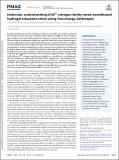| dc.contributor.author | Khare, Eesha | |
| dc.contributor.author | Cazzell, Seth Allen | |
| dc.contributor.author | Song, Jake | |
| dc.contributor.author | Holten-Andersen, Niels | |
| dc.contributor.author | Buehler, Markus J | |
| dc.date.accessioned | 2023-03-16T13:34:56Z | |
| dc.date.available | 2023-03-16T13:34:56Z | |
| dc.date.issued | 2023-01-24 | |
| dc.identifier.uri | https://hdl.handle.net/1721.1/148575 | |
| dc.description.abstract | <jats:p>
Incorporating dynamic metal-coordination bonds as cross-links into synthetic materials has become attractive not only to improve self-healing and toughness, but also due to the tunability of metal-coordination bonds. However, a priori determination of bond lifetime of metal-coordination complexes, especially important in the rational design of metal-coordinated materials with prescribed properties, is missing. We report an empirical relationship between the energy landscape of metal-coordination bonds, simulated via metadynamics, and the resulting macroscopic relaxation time in ideal metal-coordinated hydrogels. Importantly, we expand the Arrhenius relationship between the macroscopic hydrogel relaxation time and metal-coordinate bond activation energy to include width and landscape ruggedness identified in the simulated energy landscapes. Using biologically relevant Ni
<jats:sup>2+</jats:sup>
-nitrogen coordination complexes as a model case, we demonstrate that the quantitative relationship developed from histidine-Ni
<jats:sup>2+</jats:sup>
and imidazole-Ni
<jats:sup>2+</jats:sup>
complexes can predict the average relaxation times of other Ni
<jats:sup>2+</jats:sup>
-nitrogen coordinated networks. We anticipate the quantitative relationship presented here to be a starting point for the development of more sophisticated models that can predict relaxation timescales of materials with programmable viscoelastic properties.
</jats:p> | en_US |
| dc.language.iso | en | |
| dc.publisher | Proceedings of the National Academy of Sciences | en_US |
| dc.relation.isversionof | 10.1073/pnas.2213160120 | en_US |
| dc.rights | Creative Commons Attribution-NonCommercial-NoDerivs License | en_US |
| dc.rights.uri | http://creativecommons.org/licenses/by-nc-nd/4.0/ | en_US |
| dc.source | PNAS | en_US |
| dc.title | Molecular understanding of Ni2+-nitrogen family metal-coordinated hydrogel relaxation times using free energy landscapes | en_US |
| dc.type | Article | en_US |
| dc.identifier.citation | Khare, Eesha, Cazzell, Seth Allen, Song, Jake, Holten-Andersen, Niels and Buehler, Markus J. 2023. "Molecular understanding of Ni2+-nitrogen family metal-coordinated hydrogel relaxation times using free energy landscapes." Proceedings of the National Academy of Sciences, 120 (4). | |
| dc.contributor.department | Massachusetts Institute of Technology. Department of Civil and Environmental Engineering | en_US |
| dc.relation.journal | Proceedings of the National Academy of Sciences | en_US |
| dc.eprint.version | Final published version | en_US |
| dc.type.uri | http://purl.org/eprint/type/JournalArticle | en_US |
| eprint.status | http://purl.org/eprint/status/PeerReviewed | en_US |
| dc.date.updated | 2023-03-16T13:31:28Z | |
| dspace.orderedauthors | Khare, E; Cazzell, SA; Song, J; Holten-Andersen, N; Buehler, MJ | en_US |
| dspace.date.submission | 2023-03-16T13:31:30Z | |
| mit.journal.volume | 120 | en_US |
| mit.journal.issue | 4 | en_US |
| mit.license | PUBLISHER_CC | |
| mit.metadata.status | Authority Work and Publication Information Needed | en_US |
